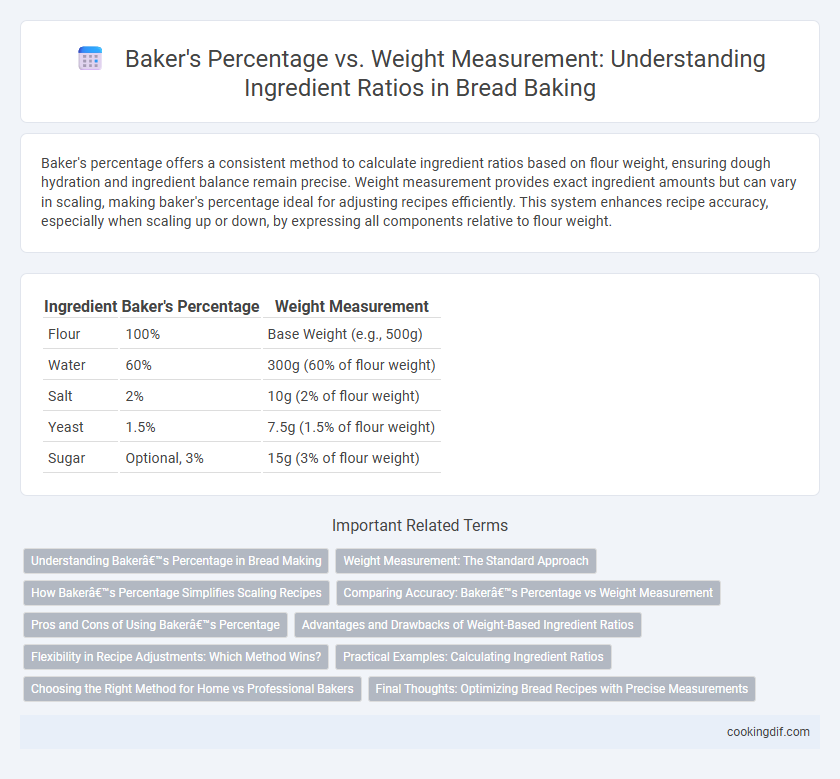Baker's percentage offers a consistent method to calculate ingredient ratios based on flour weight, ensuring dough hydration and ingredient balance remain precise. Weight measurement provides exact ingredient amounts but can vary in scaling, making baker's percentage ideal for adjusting recipes efficiently. This system enhances recipe accuracy, especially when scaling up or down, by expressing all components relative to flour weight.
Table of Comparison
| Ingredient | Baker's Percentage | Weight Measurement |
|---|---|---|
| Flour | 100% | Base Weight (e.g., 500g) |
| Water | 60% | 300g (60% of flour weight) |
| Salt | 2% | 10g (2% of flour weight) |
| Yeast | 1.5% | 7.5g (1.5% of flour weight) |
| Sugar | Optional, 3% | 15g (3% of flour weight) |
Understanding Baker’s Percentage in Bread Making
Baker's percentage expresses ingredient ratios in relation to the total flour weight, allowing precise control over dough hydration and consistency. Each ingredient is calculated as a percentage of the flour weight, enabling bakers to scale recipes easily and maintain uniform results. This method improves accuracy in bread making compared to traditional weight measurements, which vary depending on batch size and ingredient proportions.
Weight Measurement: The Standard Approach
Weight measurement is the standard approach for ingredient ratios in bread baking, offering precise control over flour, water, yeast, and salt proportions. Using grams or ounces ensures consistent dough hydration and fermentation, crucial for reproducible texture and crumb structure. This method eliminates variability caused by volume differences, enhancing accuracy in scaling recipes and improving overall baking quality.
How Baker’s Percentage Simplifies Scaling Recipes
Baker's percentage simplifies scaling bread recipes by expressing each ingredient as a percentage of the flour weight, allowing easy adjustments regardless of batch size. This method eliminates confusion inherent in weight measurements, ensuring consistent ratios and replicable results when increasing or decreasing dough volume. Bakers can quickly calculate ingredient amounts by multiplying the flour weight by each ingredient's percentage, streamlining recipe adaptation for any production scale.
Comparing Accuracy: Baker’s Percentage vs Weight Measurement
Baker's percentage offers a standardized method for comparing ingredient ratios relative to flour weight, enabling consistent recipe scaling and adjustment across various batch sizes. Weight measurement provides absolute ingredient quantities crucial for precise formulation and consistent product quality in commercial baking. While baker's percentage enhances flexibility and proportional understanding, weight measurement ensures exactness, making both essential depending on baking accuracy requirements.
Pros and Cons of Using Baker’s Percentage
Baker's percentage offers precise ingredient ratios based on flour weight, ensuring consistent dough hydration and predictable bread texture, which is crucial for professional baking scalability. This method streamlines recipe adjustments and scaling, reducing errors compared to weight measurements expressed in absolute units that can vary widely by batch size. However, baker's percentage may confuse novice bakers unfamiliar with its relative calculation, slowing initial recipe development and requiring accurate flour weight determination for effectiveness.
Advantages and Drawbacks of Weight-Based Ingredient Ratios
Weight-based ingredient ratios in bread baking provide precise control over ingredient quantities, ensuring consistent dough hydration and texture across batches. This method simplifies scaling recipes up or down without altering the final product's quality, making it ideal for professional and home bakers focused on accuracy. However, it requires accurate digital scales and can be less intuitive for beginners compared to volume measurements, leading to potential errors if equipment is unavailable or improperly used.
Flexibility in Recipe Adjustments: Which Method Wins?
Baker's percentage offers superior flexibility in recipe adjustments by expressing each ingredient as a percentage of flour weight, allowing easy scaling and ingredient substitution without recalculating total weights. Weight measurement relies on fixed quantities, making proportionate changes more complex when scaling recipes or modifying ingredient ratios. For bakers aiming to customize dough hydration or enrich recipes with mix-ins, baker's percentage streamlines precise and consistent modifications.
Practical Examples: Calculating Ingredient Ratios
Baker's percentage expresses each ingredient's weight as a percentage of the flour weight, simplifying recipe scaling and ingredient substitutions. For example, in a dough with 500g flour, 60% water means 300g water, and 2% salt equals 10g salt, making ratio calculations straightforward. Weight measurement uses absolute quantities, which can be less flexible when adjusting batch sizes, whereas baker's percentage ensures consistent ingredient proportions regardless of total dough weight.
Choosing the Right Method for Home vs Professional Bakers
Baker's percentage expresses ingredient ratios based on flour weight, providing consistency and scalability essential for professional bakers managing large batches and complex formulas. Weight measurement, often using grams or ounces, offers simplicity and precision preferred by home bakers for straightforward recipes and small-scale baking. Selecting the right method depends on baking scale: baker's percentage suits professionals aiming for reproducibility, while weight measurement serves home bakers prioritizing ease and accuracy.
Final Thoughts: Optimizing Bread Recipes with Precise Measurements
Baker's percentage offers a more reliable method for scaling bread recipes by expressing each ingredient as a ratio of the flour weight, ensuring consistent dough hydration and texture. Weight measurement provides accuracy over volume, which can vary due to ingredient density and packing. Combining baker's percentage with exact weight measurements optimizes recipe adjustments for consistent, high-quality bread outcomes.
Baker’s percentage vs Weight measurement for ingredient ratios Infographic

 cookingdif.com
cookingdif.com